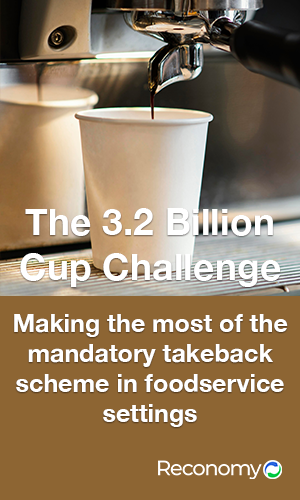Following the failure of voluntary measures, the government says mandatory calorie labelling is needed to help tackle obesity. But opponents claim it risks stifling innovation and increasing waste. Nick Hughes reports.
Like so many of the policies contained in the government’s latest obesity strategy the decision to require calorie labelling on menus instantly divided opinion. Campaigners, including Action on Sugar and Salt, praised a measure they said would “help people make healthier, informed choices”, but UKHospitality warned “the extra regulatory and cost burdens” of calorie labelling “could not come at a worse time” for businesses already at high risk of insolvency due to covid-19.
Chains such as JD Wetherspoon and Subway have led the way in showing that calorie labelling can be provided at the point of sale. But will making it mandatory on menus help reduce obesity rates? Or does the policy risk creating unintended consequences such as reducing innovation and increasing waste?
First, the details:
- The government will legislate to introduce calorie labelling for businesses in England with over 250 employees;
- Calorie information will need to be provided to customers at the point of choice, including online;
- Businesses will be required to calculate calorie content per portion of food or drink item sold, making clear to the consumer what a standard portion size is, and display it alongside a declaration referring to the recommended daily calorie intake;
- Labels will be required for all items that are prepared and sold for immediate consumption by the final consumer and are not subject to existing pre-packaged labelling requirements. This includes sides and toppings but not loose fruit or vegetables or general use condiments where they are added by the consumer;
- The requirement covers restaurants, cafés, takeaways, bakeries and caterers as well as supermarkets, entertainment venues such as cinemas, and hotels where food is served. Workplaces, where a large catering company provides the food and drink on sale, will also be required to label calories, however companies that provide their own food and drink solely for their employees are excluded;
- Online platforms, irrespective of size, will be required to display calories on their platforms of any businesses and products in scope of the policy. It will be the responsibility of the business making the food or drink to calculate and provide calorie information and the responsibility of the online platform to ensure the information is displayed appropriately.
Businesses with fewer than 250 employees will be exempt from the new rules but are not entirely off the hook. The government said it would review the policy within five years of its implementation and will consider extending the requirement to include smaller businesses. In the meantime, SMEs are encouraged to voluntarily provide calorie labelling.
Net benefits from calorie labelling
In its recently published response to a consultation on calorie labelling, held back in 2018, the government set out the case for a policy it expects to provide a net benefit to the economy of £5.5bn over a 25-year period. It pointed to evidence which suggests eating out accounts for 20-25% of adult energy intake, and that when someone dines out or eats a takeaway meal they consume, on average, 200 more calories per day than if they eat food prepared at home. Portions of food or drink consumed outside the home also contain on average twice as many calories as equivalent retailer own-brand or manufacturer-branded products, the document says.
Public demand for calorie labelling is reported to be strong with 79% of respondents to a Public Health England survey believing menus should include the number of calories in food and drinks. It should be noted, however, that the survey was from 2018 when the sector was in rude health; public sentiment over a policy that is estimated to come at a cost to businesses of up to £300m over a 25-year period may have shifted given the challenges currently facing hospitality businesses as a result of covid-19.
Perhaps the clinching argument is that businesses have had plenty of opportunity to introduce calorie labelling of their own accord. As far back as 2011, companies were asked to pledge to provide calorie information on menus or menu boards as part of the government’s Public Health Responsibility Deal. In total, 45 businesses signed the pledge, but a study carried out last year, published in the BMC Public Health journal, found that some signatories did not display calorie labels and many of those who did were not found to meet public health labelling recommendations around prominence and consistency. In fact, of the 104 major eating out and takeaway food chains studied by researchers just 18 provided in-store calorie labelling. However, half of those who did not display calories in-store were able to provide the information on request.
In short, voluntary measures haven’t worked. But will mandatory measures help bring down obesity rates? The researchers who carried out the BMC Public Health study found some evidence that calorie labelling reduces the number of calories ordered in restaurants although the effect has not been consistently shown across all studies to date. They also cited studies suggesting that when businesses are required to provide calorie information it results in a small reduction to the calorie content of products being sold due to product reformulation or replacement.
Yet the researchers’ admission that calorie labelling in isolation “is unlikely to bring about substantial improvements in population level nutrition and obesity” may be seized on by opponents as evidence that the policy is toothless. Indeed, some academics argue that a focus on calories is fundamentally flawed since they do not reflect the ways in which humans obtain nutrients from food. Concerns have been raised too that putting calories on menus presents a danger for people with eating disorders.
Beyond health and wellbeing, there are fears the policy will have a negative effect in other areas such as business commitments to source local, seasonal ingredients. Nicholls reacted to the government’s obesity plan by highlighting that with menu labelling estimated to cost as much as £40,000 per menu run for some businesses, according to the trade body, the policy risks stifling innovation. “Cooking from scratch is what restaurants do every day, and it’s how many of them manage to keep their offers attractive, with changing daily specials and locally-sourced seasonal dishes,” Nicholls says, adding that mandatory menu labelling risks “disincentivising such innovative and sustainable approaches, and stifling the efforts to offer exciting and healthy meals to customers”.
And what of waste? Feedback to the consultation suggested that businesses often make use of temporary menu items to use leftover ingredients thereby minimising food waste. A requirement to calorie label such items, it was argued, may discourage this kind of good practice. The government appears to have taken on board such concerns and has exempted from the requirement temporary items that are on the menu for less than 30 days.
One question that remains unanswered is exactly how the law will be enforced. The consensus among consultation respondents was that enforcement should be through local authority checks of food businesses within their areas, potentially as part of existing food hygiene checks. But environmental health officers are already under-resourced and the addition of a non-food safety issue to their remit seems unlikely to be seen as a priority, notwithstanding the time, manpower and expertise required to verify the accuracy of calorie information.
One senior environmental health officer says: “Absolutely calorie labelling is important, especially with obesity clearly being a risk factor for covid-19, but even with ring-fenced funding for enforcement we just haven’t got the staff.”
Unless the new law is rigorously policed the temptation for businesses to come up with a “finger in the air” estimate of calorie contents to demonstrate their compliance will surely be strong.
Calorie labelling is a policy that has been a long time in the making. It will be longer still until its effectiveness, and any unintended consequences, are fully revealed.














